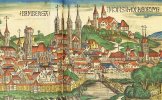-
Sign up or login, and you'll have full access to opportunities of forum.
You are using an out of date browser. It may not display this or other websites correctly.
You should upgrade or use an alternative browser.
You should upgrade or use an alternative browser.
The last Witch of Bamberg
- Thread starter Rupert_137
- Start date

damhouder
Assistant executioner
Epilogue
This brings my story “The Last Witch of Bamberg” against a gloomy, historical background to an end. I hope you enjoyed it.
The main character, authentic victim and tragic heroine of the story is Eva Maria Bachlin. She is historically documented as the unmarried daughter of Michael Bach. Because of the low marriage age for girls at the time, she should not have been over 20 years old, rather younger. I assumed 19 years for my story. Further historical facts are the date of her conviction (December 17, 1630), her sentence (grip twice with red-hot pliers, then burn), the writing of her will on December 18. (the content has not been passed down), the date and place of her execution (December 20, 1630 in Zell near Bamberg).
Eva Maria Bachlin was one of the last victims of the Bamberg witch trials, which raged in three waves between 1595 and 1630, claiming about 1000 victims and culminating in the beginning of 1628 until mid-1630 (about 300 victims in 2½ years). Occasionally there were further witch trials up to 1680, thanks for the hint from ‘Naraku’ (# 17).
'Herrenberger' as her antagonist is also one of at least four witch commissioners in Bamberg in 1628/30 who are documented in the city's archives (as Dr. Herrenberger, i.e. with the academic degree of a doctorate). Herrenberger is initially just a henchman, but one who carries out his works conscientiously, convincingly and with great commitment and thus becomes an accomplice. In this story I have limited myself to him by name, although he did not act alone and, as mentioned, there were other witch commissioners.
The instigator and actual perpetrator is Prince Bishop Johann Georg II Fox of Dornheim, who stays in the background. He only lets the chosen victim briefly shown to himself – that’s my literary vision. In any case, it seems that the bishop wanted to set the “sign” again in December 1630, “the witch burnings are continuing in Bamberg” after external circumstances forced an interruption of the witch trials in the second half of 1630 (see Chapter 1 + 2 of my story and post # 17 by ‘Naraku’).
Against this background, Eva Maria Bachlin became a particularly tragic victim for me as ‘the chosen one’ in the negative, unfortunate sense. And as the 'chosen one' for a witch burn before Christmas (by the bishop and witch commissioners) she not only had to endure the unimaginable suffering of torture and burning at the stake, but was also tortured particularly cruelly with red-hot pliers - which was spared most of the other victims.
In 1631 the war turned when the Swedish King Gustav II Adolf intervened to support the Protestants. Prince-Bishop Johann Georg fled the Swedish-Saxon troops to Austria in 1632, where he died a little later in March 1633.
All other, purely fictional characters in this story are followers or observers. All the details of the plot described here are fiction. This also applies in particular to 'Hans Michael', the victim's brother. It would be unlikely that he actually helped with the preparations. But I wanted to add him to the story as a personally affected person and as a 'close-up observer'. And looking back, I have to say that without the brother something essential would have been missing.
I’m assuming that the historical persons named here have remained childless or today, after almost 400 years, there are no direct, living descendants who feel offended in any way by my descriptions - in any case, this was not my intention!
I tried to write this story as realistically as possible; but I also took the artistic freedom to deviate from the presumed reality a little here and there (see brother) ... The reality at that time was so brutal and cruel that there was no reason for further exaggerations, just a few embellishments here and there to make the story a little more interesting for you to read it.
In the end, I tried to translate the draft text I had written in German into a decent English (Google helps, but you have to check each sentence carefully). Sure, I haven't always found the right terms or phrases and sometimes overlooked the fact that Google has a preference for the plural and that it should be “her” instead of “their” in the text. Please excuse this.
Thanks for your interest!
damhouder
Assistant executioner
Rupert, I appreciate very much what had to have been a great deal of labor to compose this story. I've always thought that one of the best ways to develop a bdsm themed work on the subject of witch trials was to meld fact and fiction as you have in this work. When it comes to bdsm as fantasy it is difficult to top witch hunting with its mix of sex and pain. The naked or at least half naked accused witch in the torture chamber, often shaved of all hair and minutely examined for witch marks and any amulets that would help her resist any torture seems to me to be the perfect bdsm subject.
damhouder
Assistant executioner
Epilogue
This brings my story “The Last Witch of Bamberg” against a gloomy, historical background to an end. I hope you enjoyed it.
The main character, authentic victim and tragic heroine of the story is Eva Maria Bachlin. She is historically documented as the unmarried daughter of Michael Bach. Because of the low marriage age for girls at the time, she should not have been over 20 years old, rather younger. I assumed 19 years for my story. Further historical facts are the date of her conviction (December 17, 1630), her sentence (grip twice with red-hot pliers, then burn), the writing of her will on December 18. (the content has not been passed down), the date and place of her execution (December 20, 1630 in Zell near Bamberg).
Eva Maria Bachlin was one of the last victims of the Bamberg witch trials, which raged in three waves between 1595 and 1630, claiming about 1000 victims and culminating in the beginning of 1628 until mid-1630 (about 300 victims in 2½ years). Occasionally there were further witch trials up to 1680, thanks for the hint from ‘Naraku’ (# 17).
'Herrenberger' as her antagonist is also one of at least four witch commissioners in Bamberg in 1628/30 who are documented in the city's archives (as Dr. Herrenberger, i.e. with the academic degree of a doctorate). Herrenberger is initially just a henchman, but one who carries out his works conscientiously, convincingly and with great commitment and thus becomes an accomplice. In this story I have limited myself to him by name, although he did not act alone and, as mentioned, there were other witch commissioners.
The instigator and actual perpetrator is Prince Bishop Johann Georg II Fox of Dornheim, who stays in the background. He only lets the chosen victim briefly shown to himself – that’s my literary vision. In any case, it seems that the bishop wanted to set the “sign” again in December 1630, “the witch burnings are continuing in Bamberg” after external circumstances forced an interruption of the witch trials in the second half of 1630 (see Chapter 1 + 2 of my story and post # 17 by ‘Naraku’).
Against this background, Eva Maria Bachlin became a particularly tragic victim for me as ‘the chosen one’ in the negative, unfortunate sense. And as the 'chosen one' for a witch burn before Christmas (by the bishop and witch commissioners) she not only had to endure the unimaginable suffering of torture and burning at the stake, but was also tortured particularly cruelly with red-hot pliers - which was spared most of the other victims.
In 1631 the war turned when the Swedish King Gustav II Adolf intervened to support the Protestants. Prince-Bishop Johann Georg fled the Swedish-Saxon troops to Austria in 1632, where he died a little later in March 1633.
All other, purely fictional characters in this story are followers or observers. All the details of the plot described here are fiction. This also applies in particular to 'Hans Michael', the victim's brother. It would be unlikely that he actually helped with the preparations. But I wanted to add him to the story as a personally affected person and as a 'close-up observer'. And looking back, I have to say that without the brother something essential would have been missing.
I’m assuming that the historical persons named here have remained childless or today, after almost 400 years, there are no direct, living descendants who feel offended in any way by my descriptions - in any case, this was not my intention!
I tried to write this story as realistically as possible; but I also took the artistic freedom to deviate from the presumed reality a little here and there (see brother) ... The reality at that time was so brutal and cruel that there was no reason for further exaggerations, just a few embellishments here and there to make the story a little more interesting for you to read it.
In the end, I tried to translate the draft text I had written in German into a decent English (Google helps, but you have to check each sentence carefully). Sure, I haven't always found the right terms or phrases and sometimes overlooked the fact that Google has a preference for the plural and that it should be “her” instead of “their” in the text. Please excuse this.
Thanks for your interest!
damhouder
Assistant executioner
An interesting point that you bring up is in not wanting to drag into old controversies present day people whose ancestors were involved in witch trials. From what I have read on this subject the laws that allowed for (and mandated) certain procedures to be carried out were only expunged from the criminal justice system in the late 18th and early 19th centuries. And apparently when those laws were repealed there was a considerable effort , especially by people in towns and villages whose ancestors had a role in conducting witch trials, to gather up and destroy many of the archives which implicated their forbearers. People, especially with advanced educations and of high social standing, didn't want their neighbors to know of how their ancestors had played a role in destroying innocent lives. And that expunging of the record would indicate that there probably were a lot more witch trials than is commonly believed nowadays.
Rupert_137
Governor
Thank you for your feedback, Damhouder!An interesting point that you bring up is in not wanting to drag into old controversies present day people whose ancestors were involved in witch trials. From what I have read on this subject the laws that allowed for (and mandated) certain procedures to be carried out were only expunged from the criminal justice system in the late 18th and early 19th centuries. And apparently when those laws were repealed there was a considerable effort , especially by people in towns and villages whose ancestors had a role in conducting witch trials, to gather up and destroy many of the archives which implicated their forbearers. People, especially with advanced educations and of high social standing, didn't want their neighbors to know of how their ancestors had played a role in destroying innocent lives. And that expunging of the record would indicate that there probably were a lot more witch trials than is commonly believed nowadays.
When I looked through the online compilation "Protocols of the Bamberg Witch Trials, List of Victims' Names" [that was certainly a laborious job, because the manuscripts of that time are difficult to read today] I noticed that the witch commissioners were all gentlemen with an academic doctorate, probably doctorates in law. From today's perspective, they were responsible for hundreds of judicial murders! When it slowly became clear that witchcraft and sorcery were impossible, it was certainly a great burden for the families if, for example, the grandfather - previously a respected and honorable person - had taken part ...
But even without deliberately deleting documents, there are gaps. The victims in the Bamberg compilation can be counted, I was content with estimating: 5 to 6 entries per page, 66 pages gives 300 to 400 victims for the period 1628 to 1630; Wikipedia only gives 235 victims for the period from 1625 to 1630 at. I can hardly misjudge myself that much. And when I wanted to research individual cases, I found evidence of mother or daughter who were also burned (even with the date), but there was no separate entry, certainly other entries were missing completely ... Then you are actually closer to 400 victims ( + 70% compared to Wikipedia). And the witch hunt in Bamberg is really well documented compared to other cities!
gerembeau
Tribune
I especially appreciate your efforts to have a real historical background for your stories. To know that the breastrippers show was effective, and many people could have a view on the tortured tits is extremely moving. Our words to describe such a scene in our stories are pitiful, in fact.
Anyway, may we have the part of the german text where the torture is related ?
Anyway, may we have the part of the german text where the torture is related ?
damhouder
Assistant executioner
It has to be highly deflating to any notion that The Enlightenment necessarily brought about immediate and positive changes in human consciousness to consider the fact that the witch hunts raged primarily in the period from the late 1500's all the way almost to the time of the American Revolution while the so-called Dark Ages were almost free of the notion. As you've noted, your own researches into actual records show lots of gaps and lumping together of victims which indicate a probably severe undercount of the total. And it needs to be kept in mind just how profitable an enterprise that witch hunting became for so many officials. Every act of imprisonment, torture and execution came with a heavy price tag. In one instance that I read about the cost for an imprisonment for about 4 months, one torture and one examination for the witch's mark including shaving was some 70 Thalers, an amount which probably was equal to several years of earnings for an ordinary worker. And it was that well educated minority who filled official posts who were situated to benefit from the panics and who probably laid the foundations of comfortable family fortunes that sill benefit their descendants to this day.Thank you for your feedback, Damhouder!
When I looked through the online compilation "Protocols of the Bamberg Witch Trials, List of Victims' Names" [that was certainly a laborious job, because the manuscripts of that time are difficult to read today] I noticed that the witch commissioners were all gentlemen with an academic doctorate, probably doctorates in law. From today's perspective, they were responsible for hundreds of judicial murders! When it slowly became clear that witchcraft and sorcery were impossible, it was certainly a great burden for the families if, for example, the grandfather - previously a respected and honorable person - had taken part ...
But even without deliberately deleting documents, there are gaps. The victims in the Bamberg compilation can be counted, I was content with estimating: 5 to 6 entries per page, 66 pages gives 300 to 400 victims for the period 1628 to 1630; Wikipedia only gives 235 victims for the period from 1625 to 1630 at. I can hardly misjudge myself that much. And when I wanted to research individual cases, I found evidence of mother or daughter who were also burned (even with the date), but there was no separate entry, certainly other entries were missing completely ... Then you are actually closer to 400 victims ( + 70% compared to Wikipedia). And the witch hunt in Bamberg is really well documented compared to other cities!
Rupert_137
Governor
Thanks for your feedback, Gerembeau!I especially appreciate your efforts to have a real historical background for your stories. To know that the breastrippers show was effective, and many people could have a view on the tortured tits is extremely moving. Our words to describe such a scene in our stories are pitiful, in fact.
Anyway, may we have the part of the german text where the torture is related ?
I think it's about chapter 5a + b of my story.
The not historically documented 'encore' with the 'cold crocodile tongs' in this section was actually inspired by corresponding pliers models that I found on the internet as pictures under the keyword 'witch pliers' and by your invitation to post my contribution on your Breastripper Saga . I will send the editable complete texts in German and English to your mailbox.
Rupert_137
Governor
toxidomaskjr
Magistrate
Really nice story! I just wish that somehow the witch was a modern times woman (time travel, reenacment maybe)
Rupert_137
Governor
Time travel would be an interesting thing, but I don't think we humans today could endure the reality of that time. Because that's how it really happened. Dates, places, names and the punishments are right ... the journey through time could be precisely determined. But just think what crowd of time visitors there would be in Golgotha befor the Passover festival in AD 30?Really nice story! I just wish that somehow the witch was a modern times woman (time travel, reenacment maybe)
Silent_Water
Tribune
Mhm, maybe "the truth somewhere out there" is more phantastic than everyone of us could ever imagine and we do not really need to make time travels because "somewhere out there" might be someone who has observed us for thousands of years!
For example, I was really impressed by the history of the so-called "Omni-wheel" which is really used in complicated wheeled machines and which was patented by Joseph F. Blumrich, a former NASA engineer.
He had the idea for developing and patenting this wheel when he was reading the Bible story of prophet Ezekiel, assuming he did not receive his prophecies by God or his angels but by ancient alien astronauts because this prophet Ezekiel described not only the angels but the devices they used to fly and Blumrich asked himself: Why does an angel need a flying device in order to fly when he has wings on his own?
Indeed, this story is one of the most unusual in the whole "Holy Bible" and Blumrich constructed his "Omni-wheel" according to the idea, that Ezekiel once witnessed and saw the real changeable wheel of a real "spaceship lander":

 en.wikipedia.org
en.wikipedia.org
This is the only example I know of a modern patent in our days inspired by a story which is about 2.500 years old!
Imagine now that Blumrich might have been right and there were "ancient alien astronauts" visiting human mankind in those days, interfering in "our" history, watching our development ... why should they not have made descriptions and films or something similar about our history?
Maybe, somewhere in our universe, there are really films or something similar existing about the building of the Pyramides of Gizah or Julius Caesar's "Bello Gallico" or Napoleon's defeat at Waterloo, filmed from above and maybe one day far in the future, those "movie-makers" will think:
"OK, these so-called humans managed to live now some decades enough without killing each other in their senseless religious or political wars. Maybe, they are now similar intelligent as we are already for millions of years. We will tell them what we know about their past and possibly how to survive the problems of the future ..."
For example, I was really impressed by the history of the so-called "Omni-wheel" which is really used in complicated wheeled machines and which was patented by Joseph F. Blumrich, a former NASA engineer.
He had the idea for developing and patenting this wheel when he was reading the Bible story of prophet Ezekiel, assuming he did not receive his prophecies by God or his angels but by ancient alien astronauts because this prophet Ezekiel described not only the angels but the devices they used to fly and Blumrich asked himself: Why does an angel need a flying device in order to fly when he has wings on his own?
Indeed, this story is one of the most unusual in the whole "Holy Bible" and Blumrich constructed his "Omni-wheel" according to the idea, that Ezekiel once witnessed and saw the real changeable wheel of a real "spaceship lander":

The Spaceships of Ezekiel - Wikipedia
 en.wikipedia.org
en.wikipedia.org
This is the only example I know of a modern patent in our days inspired by a story which is about 2.500 years old!
Imagine now that Blumrich might have been right and there were "ancient alien astronauts" visiting human mankind in those days, interfering in "our" history, watching our development ... why should they not have made descriptions and films or something similar about our history?
Maybe, somewhere in our universe, there are really films or something similar existing about the building of the Pyramides of Gizah or Julius Caesar's "Bello Gallico" or Napoleon's defeat at Waterloo, filmed from above and maybe one day far in the future, those "movie-makers" will think:
"OK, these so-called humans managed to live now some decades enough without killing each other in their senseless religious or political wars. Maybe, they are now similar intelligent as we are already for millions of years. We will tell them what we know about their past and possibly how to survive the problems of the future ..."
Rupert_137
Governor
One year after the completion of my first publication of "The last Witch of Bamberg" I decided to revise the entire text again - in particular, I adapted the descriptions more precisely to the real local conditions at that time. I added a new cover sheet, added photos of historical buildings and historical maps...
The results in English and German can be found in the attachment.
Have fun, Rupert




The results in English and German can be found in the attachment.
Have fun, Rupert




Attachments
I replaced both in the archive:


